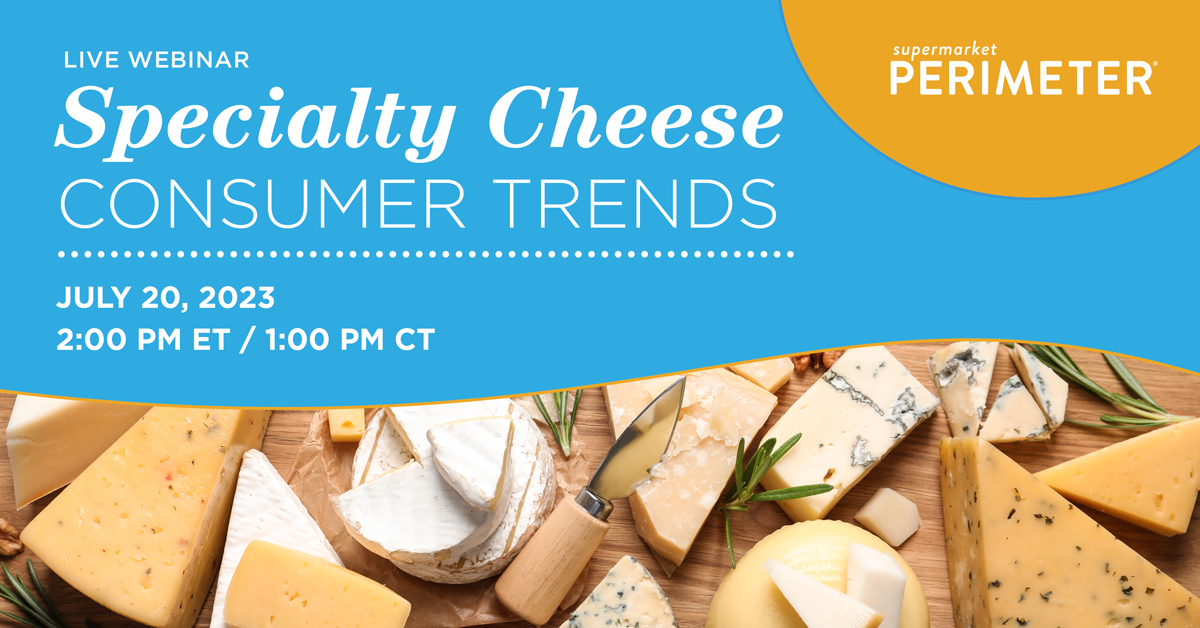Even during inflationary times, demand for higher-priced specialty cheeses is surging, as Americans look for ways to add flavor and a little restaurant glamor to their home-cooked meals, charcuterie boards and snacks.
Sixty-four percent of Americans have purchased specialty cheeses in the past three months, according to new consumer research conducted for Supermarket Perimeter by Kansas City, Mo.-based Cypress Research.
The research also found that those most likely to purchase specialty cheeses include the young, the more affluent, Hispanics, families with children under 18 and – perhaps most surprisingly – men.
According to the research, 71% of the youngest consumers surveyed – Gen Zers aged 21 to 25 – purchased specialty cheeses in the past three months, more than any other demographic.
Gen Xers were the second most likely to purchase (67%), followed by millennials (66%) and baby boomers (59%).
That jibes with what Rachel Shemirani, senior vice president of Poway, Calif.-based retailer Barons Market, is seeing in her company’s stores.
“I think with the help of social media, especially platforms such as Tik Tok, Gen Z has visual access to different types of specialty cheeses, especially those in other countries, and how to use them in recipes and pair them with other foods and drinks.”
Shemirani was surprised by the finding that men purchase specialty cheese more often than women (71% to 61%). But she’s not as surprised by it as she might have been a few years ago.
“Ten years ago, I would say most of our shoppers were women, but it’s not the case today. There are more men responsible for grocery shopping for their household than ever before.”
The more money you make, the more likely you are to buy specialty cheeses, according to the research.
Nearly three out of four households – 74% – with income above $100,000 bought specialty cheeses in the past three months. That compares to 70% of those making $50,000 - $99,999 and 56% of those making less than $50,000.
By race, non-whites were more likely to buy specialty cheeses than whites. Hispanics lead the way, with 72% purchasing, followed by Blacks (65%) and whites (62%).
California is the top Hispanic cheese producer in the country, and the state’s processors are continuing to grab market share throughout the country, said Katelyn Harmon, director of business development, U.S. Retail, for the California Milk Advisory Board.
“Growth in the deli cheese category stems from several different segments, but Hispanic cheese specifically is leading the charge,” Harmon said, citing State of Cheese data from IRI/Circana that shows that dollar cheese sales rose from $9.1 billion to $9.5 billion in the 52 weeks ending Jan. 29.
Most people may not associate “kids” with “specialty cheese,” but the Supermarket Perimeter study found that 70% of households with children under the age of 18 purchase it, compared to 60% of households without children under 18.
Marital status also affects how often Americans buy specialty cheeses. Leading the way are married couples (71% purchase), followed by widowers (64%), people who have never married (58%) and divorced or separated consumers (both 57%).
For Barons, seasonal, limited-production and flavored cheeses are “really popular,” Shemirani said.
In addition, Barons has many customers loyal to certain brands, so the retailer makes sure it tracks those carefully and keeps branded produce well stocked.
The retailer’s cheese experts are constantly trying to keep up with the market, she said.
“Our buyers will go to specialty cheese shows, read industry publications and work with our cheese brokers to see what’s new and exciting. We also gather customer requests and if we’re seeing a brand or type of cheese over and over again in the requests, we’ll pursue it.”
The specialty category is definitely growing, Shemirani said – both in demand and in the number of products available. One megatrend in particular deserves a lot of the credit.
“With the rise in charcuterie and cheese boards, customers are really excited about finding new cheeses. It’s an exciting category all around.”
Merchandising musts
When it comes to merchandising specialty cheeses at grocery retail, sampling plays a huge role, Shemirani said.
It’s also important to cross-merchandise with complimentary items such like cured meats, crackers, fresh baguettes and wine.
“It creates a very dynamic display that customers really respond to,” Shemirani said.
In-store, there’s a few things that can help retailers stand out on the shelf, Harmon said.
“Focusing on ‘heavy appetite appeal’ signage at shelf to draw in the shopper with a little meal inspiration is a great way to grab their attention,” she said. “Adding in heavy-appetite appeal recipe take ones that provide inspiration but are budget friendly are a staple.”
Working with retailers to spotlight California cheeses in special sections or within the existing case during a cheese promotion increases visibility, she added.
And now that sampling demos are somewhat back, utilizing them to get shoppers to taste a new cheese can be the final factor that gets it in the shopper’s basket, Harmon said. Implementing value offers where it makes sense is also more important than ever.
Even with the uptick in in-store shoppers, largely attributed to an increase in trip count and less spend per trip, shoppers are looking to get in and out of the store quickly, Harmon said, so getting on their list ahead of time is increasingly important. “Reaching shoppers before they get to the store, when they are in recipe research model and building their shopping list, is an important first step in growing awareness and, ultimately, sales.”
Retailers and their specialty cheese producer partners need to continue to adjust to persistent inflationary pressures, Harmon said.
“Everyone’s volume is contracting a bit right now as shoppers are watching every penny and shifting their shopping habits to accommodate their tightened budgets,” she said. “We’re still seeing some growth pockets across the country for specific types of specialty cheese, but in general dollar sales are up and volume sales mostly flat.”
Inflation may flatten in the next 12 to 18 months, Harmon said, but that’s still much longer than producers and their retail partners would like.
“Shoppers are stretching their dollars as much as possible right now. Whether clipping digital coupons or using bundle offers to build their meals for the week, shoppers are paying attention and looking to save. They’re cutting back on non-essentials, delaying the purchase until the next time and trading down to store brands when available.”
And inflation isn’t the only challenge specialty cheese makers in California and other regions face.
“Our input costs remain elevated – even though the price of milk has mostly peaked, high cream prices are still impacting specialty cheese varieties that utilize it,” Harmon said. “And transportation has always been a challenge – transporting perishable, and sometimes short shelf-life items, to the other side of the country can be complicated at best. We’re hearing that transportation costs aren’t as bad as they were, but are still a factor in the elevated prices commanded in certain parts of the country.”
For California producers, highlighting their home state has proved to be one way of navigating tougher economic times.
Nationwide, volume sales for specialty cheese with the Real California Milk seal is up 3.3% over the last 52 weeks ending May 21, Harmon said, citing IRI/Circana data. By contrast, sales of specialty cheese without the seal is down 3%.
“We know that domestic origin labeling, and even more so local connotations tied to our Real California Milk, carry our customers trust in their quality and value,” Harmon said.
Many California cheese producers are expanding their capacity and capabilities to better meet demand and grow sales throughout the country. One thing they’re doing in particular is exploring and offering new flavors and size options to meet consumer’s continued interest in specialty cheese.
“Customers are looking for easy ways to treat themselves in their grocery retail spending, so adding some blue cheese to your salad to mimic the restaurant experience or making a baked macaroni and cheese dish as something different for your family are just a few ways shoppers are indulging with their spending within the specialty department,” Harmon said.
Getting on board
Cheese and charcuterie boards and butter boards continue to be the dominant trends in the specialty cheese category, said Gayle De Caro, category manager of specialty cheese and deli merchandising for Encino, Calif.-based retail chain Gelson’s.
What’s new about the trend, De Caro said, is the inclusion of more interesting accompaniments, including crunchy elements and sweet desserts.
Gelson’s grab-and-go cheese plates, which the store’s deli workers cut and wrap in-store, make it easy for customers to have a well-curated cheese plate that’s ready to enjoy.
“We’re a company that stays connected to trends, and we pivot quickly as trends change,” De Caro said.
The specialty cheese category is strong, and one of the main drivers is a certain demographic paired with a certain technology, she added.
“Gen Zers drive the trends mainly due to TikTok. Remember the Baked Feta and Roasted Tomato Pasta TikTok videos that blew up the feta industry, and stores couldn’t keep them on their shelves?”
Gelson’s does its part to help keep demand strong by creating impactful cheese merchandising displays by showcasing jams, olives, crackers boards, beverage pairings and other items in the same area.
“Customers will most likely purchase three to five cheeses,” she said. “In addition, they’ll add six to ten accompaniments to their basket.”
About the research
Commissioned by Supermarket Perimeter, Cypress Research conducted a nationally representative consumer online survey to determine consumer trends in specialty cheese purchasing.
Survey fieldwork took place during the month of March 2023. Following are requirements for individuals to qualify for survey participation:
- A primary grocery shopper for the household
- Between the ages of 21 and 75
The survey was representative of the U.S. in terms of:
- Household income
- Region (West, South, Midwest, Northeast)
Responses were received from a nationally representative sample of 583 supermarket shoppers age 21 years and older.
Who is the specialty cheese consumer?
- 64% of Americans have purchased specialty cheeses in the past three months.
- Nearly 3 out of 4 households with income above $100,000 bought specialty cheeses in the past three months.
- 71% percent of Gen Zers purchased specialty cheeses in the past three months.
Most likely to purchase specialty cheeses:
- Gen Z
- High income groups
- Hispanics
- Men
- People who are married
- People with children over 18
Sampling success
- 81% percent sample specialty cheeses when they are available.
- 71% percent look at instore promotional signage for specialty cheeses.
- 81% percent look for sales/discounts on specialty cheese.
Which specialty cheese samples should be offered more?
- Unique varieties: 88%
- Seasonal: 87%
- Organic: 72%
Inflation's impact
- 44% buy specialty cheeses less frequently, and nearly a quarter are trading down.
- 73% say specialty cheeses are worth the money.
- 45% say when grocery shopping, they are trading down on some foods so that they can pay higher prices for things they really like.
- 43% say when grocery shopping, they are buying less espensive food in every caegory possible.
Peaking interest
- 89% enjoy trying international varieties.
- 58% look for specific brands.
- 56% look for seals of authenticity/origin for different regions or countries.
When do consumers eat specialty cheese?
- Snack: 76%
- Dinner: 61%
- Lunch: 59%
- Appetizer: 45%
- Breakfast: 31%
- Dessert: 8%
Sponsored webinar
Join us July 20th to learn about trends driving the US Specialty Cheese Consumer. Also, hear about retailer perspectives of our recent study findings as well as new product development initiatives suppliers are working on that address current trends. Register here.


